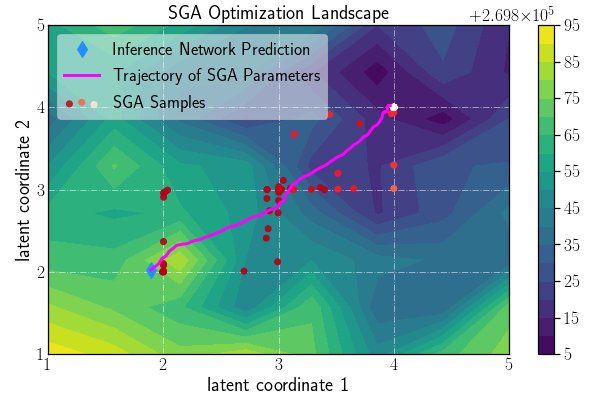Improving Inference for Neural Image Compression
This repository contains implementation of various methods considered in Improving Inference for Neural Image Compression, accepted at NeurIPS 2020:
@article{yang2020improving,
title={Improving Inference for Neural Image Compression},
author={Yang, Yibo and Bamler, Robert and Mandt, Stephan},
journal={arXiv preprint arXiv:2006.04240},
year={2020}
}
Update
03/15/2023
See a cleaner and more reusable implementation of SGA in tensorflow 2.10 in the tf2 branch.
Overview
We propose various methods to improve the compression performance of a popular and competitive neural image compression baseline model (mean-scale hyperprior model proposed by Minnen et al., 2018), at inference/compression time, based on ideas related to iterative variational inference, stochastic discrete optimization, and bits-back coding, aiming to close the approximation gaps that lie between current neural compression methods and rate-distortion optimality.
The scripts mbt2018.py (non-bits-back version) and mbt2018_bb.py (bits-back version) train the baseline models, with encoder networks
learned through amortized inference. Given trained models, the following scripts run various iterative inference methods considered in the paper
and evaluate the resulting compression performance: sga.py, map.py, ste.py, unoise.py, and danneal.py
(requiring a model pre-trained with mbt2018.py), and bb_sga.py, bb_no_sga.py, and bb_plain.py (requiring a model pre-trained with mbt2018_bb.py).
Requirements
To install requirements:
pip install -r requirements.txt
The important dependencies are python 3.6 (tested on 3.6.9), tensorflow-compression 1.3 (which requires tensorflow 1.15), and tensorflow-probability 0.7.0 for the Gumbel-softmax trick (used in Stochastic Gumbel Annealing).
Training
The following command can be used to train models in the paper:
python <train_script> --checkpoint_dir <checkpoint_dir> --num_filters <num_filters> train --train_glob=<train_glob> --batchsize 8 --patchsize 256 --save_summary_secs 600 --lambda <lambda> --last_step <last_step>
<train_script>ismbt2018.pyfor the Base Hyperprior model in paper, andmbt2018_bb.pyfor the version modified for lossy bits-back coding;<checkpoint_dir>is the overall folder of model checkpoints (this is/.checkpointsby default);<num_filters>is the number of (de)convolutional filters; in the paper we set this to 192 for most of our models following Minnen et al., 2018, except we found it necessary to increase this to 256 to match the published performance of mean-scale model at higher rate (whenlambda=0.04and0.08), following Ballé et al., 2018;<train_glob>is a string of glob pattern like "imgs/*.png" or "imgs/*.npy" (we support float32.npyformat to reduce CPU load when training); in our experiments we used CLIC-2018 images (specifically, we combined all the images from professional_train, professional_valid, professional_test, mobile_valid, and mobile_test, with no pre-processing);<lambda>is the penalty coefficient in front of the reconstruction loss (we trained with MSE loss in all experiments) and controls the rate-distortion tradeoff; see below section on pre-trained models;<last_step>is the total number of training steps; we typically used 2 million steps to reproduce the mean-scale (base hyperprior) model results from Minnen et al., 2018;batchsizeandpatchsizeare set following Ballé et al., 2018; for miscellaneous other options seetf_boilerplate.py.
Inference/Evaluation
Given a pretrained model and some image input, the following command runs some form of (improved) inference method for compression and evaluates the reconstruction results (BPP, PSNR, MS-SSIM, etc.):
python <script> --num_filters <num_filters> --verbose --checkpoint_dir <checkpoint_dir> compress <run_name> <eval_imgs> --results_dir <results_dir>
where <script> is one of the compression/evaluation scripts listed below, <num_filters> (e.g., 192) and <run_name> (e.g., mbt2018-num_filters=192-lmbda=0.001)
come from the pre-trained model
(whose checkpoint folder should belong to <checkpoint_dir>), and <eval_image> can be either a single input image,
or a numpy array of a batch of images with shape (num_imgs, H, W, 3) and type uint8.
Below we list the script used for all inference methods evaluated in the paper:
| script | method | entry in Table 1 of paper |
|---|---|---|
| mbt2018.py | Base Hyperprior | M3 |
| sga.py | SGA | M1 |
| bb_sga.py | SGA + BB | M2 |
| map.py | MAP | A1 |
| ste.py | STE | A2 |
| unoise.py | Uniform Noise | A3 |
| danneal.py | Deterministic Annealing | A4 |
| bb_no_sga.py | BB without SGA | A5 |
| bb_plain.py | BB without any iterative inference | A6 |
Rate-distortion results on Kodak and Tecnick (averaged over all images for each lambda setting) can be found in the
results folder.
Pre-trained Models
Our pre-trained models can be found here.
Download and untar them into <checkpoint_dir>, with each sub-folder corresponding to a model <runname>.
The lmbda=0.001 models were trained for 1 million steps, lmbda=0.08 models were trained for 3 million steps, and
all the other models were trained for 2 million steps.
